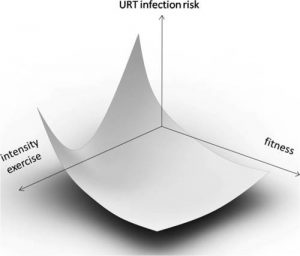Every ill athlete or performer wants to know one thing: “Can I exercise when sick today?”
As a pediatric and sports medicine specialist, I want to know a few things to make that decision:
- Is the athlete currently too ill to exercise?
- Do we have a good handle on the diagnosis or cause of the illness?
- Will exercise increase risk for more serious or longer-lasting problems?
- Could the athlete pass on the illness to others?
Each situation is unique and by no means does this article seek to provide specific advice for each person asking about exercise when sick.
However, there are some common things that must be considering in every instance when considering exercise with illness.
Exercise When Sick: Is a fever a dealbreaker?
A fever (temperature over 100.4 degrees Fahrenheit/38 degrees Celsius) may increase the workload on the body. This can often make exercise more difficult and possibly more dangerous. Rare worst case scenarios include heart infections or heatstroke. Thus, some authorities recommend not exercising if there is a fever. Others will recommend starting with lighter levels of exercise with a fever. Tolerating a lower level of exercise will allow a slow increase in intensity and amount of activity. Some athletes may perform quite adequately with a fever, while others will need complete rest until fever is gone for at least 24 hours.
Waiting at least 24 hours after fever has broken also has the benefits of reducing risk of spreading illness.
So, is there anything else besides fever that can help decide whether or not to exercise when sick?
Indeed, the neck rule can also assist in determining participation with or without a fever:
- Symptoms entirely above the neck (runny nose, sore throat, mild headache, etc) have less potential for more serious illness with exercise. Recommend light exercise at first, and if symptoms do not worsen, then gradually increasing intensity of exercise.
- Symptoms below the neck (cough with mucous, chest pain/tightness, stomach ache, vomiting/diarrhea, rash, muscle/body aches) are a more serious issue. There is a greater risk for worsening individual symptoms (like that heart infection problem) and also for spread to teammates. Hold off on any exercise until all symptoms below the neck are gone for at least 24 hours.
How about trying to limit illness in the first place?
No athlete wants to be sick and no athlete wants to be responsible for the spread illness to other team members.
Following some basic rules can help prevent the spread of infections:
- Do not share water bottles, cups, towels, washcloths, or tissues.
- Shower immediately after exercise and change into clean clothes.
- Launder athletic equipment on a regular basis.
- If prescribed medications- take them as directed for the full length of the prescription.
- Use antibiotics only for the intended illness
- Incomplete or improper use can lead to bacterial resistance and reduced function of antibiotics.
- Get adequate sleep and nutrition as fatigue and poor diets can weaken the immune system.
- No fewer than 8 hours of sleep a night with at least one rest day from exercise per week.
- At least 4-5 fruits/vegetables per day can increase ability to fight infection.
- Consider the Influenza Vaccine (flu shot) in the fall months.
- Influenza A/B viruses are common sources of illness and disability during the winter months.
- Flu shots can reduce both individual and team risks.
Are people who exercise at lower risk of illnesses?

Moreira A et al. Br Med Bull 2009;90:111-131, © The Author 2009. Published by Oxford University Press. All rights reserved. For permissions, please e-mail: journals.permissions@oxfordjournals.org
The above figure demonstrates that both intensity of exercise and fitness level can influence the risk of upper respiratory tract (URT) infection. More moderate levels of exercise can be protective against illness. Exercising at lower and higher levels of intensity may actually be related to an increased risk. This is often why athletes get sick right after higher level competitions (such as what I saw at the Olympic Games Medical Clinics) or at the end of a particular sport season. Higher levels of fitness may also be protective against respiratory illnesses.
Exercise When Sick: The Final Thoughts
Never hesitate to seek immediate medical care if ill. The individual decision to exercise when sick takes into account the long-term health not just of one athlete, but also of the entire team. Make sure you know exactly whats going on, what are the potential risks, and how to best return to the top of your game.
ActiveKidMD Video: Importance of Accurate Diagnosis and Step-wise Return after Illness or Injury


